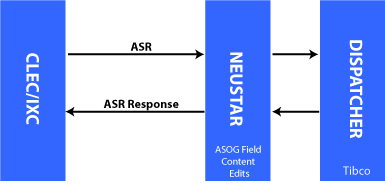You are using an unlicensed and unsupported version of Evoq Basic. Please contact customersuccess@dnnsoftware.com for information on how to obtain a valid license.
Access Service Request
 |
| Access Service Request (ASR) Processing - The ASR Release Support is ASOG 37.
- Products supported by the ASR process include:
- Feature Group A
- End User Special Access
- Part Time/Full Time Television or Program Audio
- CCS Link or Unbundled STP Port
- Trunking – FGB, C, D, Service Access Code (SAC) NXX, Wireless and Local
- Ring (Optical)
- Special Access
- Broadband Services
- WATS Access Line
- Broadband End User Services
- The maximum amount of DS1s per ASR is 10
- Customers submit ASRs through the Neustar Gateway.
- Hawaiian Telcom will also accept ASRs via fax; Wholesale Markets Call Center (WMCC) representatives will input the data into NeuStar for fax orders.
- The initial edits for ASOG standards occur in Neustar.
- After successfully completing the edits in NeuStar, the ASR is passed to Wholesale Dispatcher for a second validation for Hawaiian Telcom edits/standards. This validation includes CCNA, CLLI Codes, NC/NCI/SECNCI Combinations, Service and Product Enhancement (SPEC) Codes and others as required.
- Once the ASR has successfully passed the edits in Wholesale Dispatcher, the provisioning process is initiated.
- Orders must be error free to pass through the ordering/provisioning process. If an error is found during the design phase, as an example, it will be rejected to the customer for correction. This will impact the due date interval as the date calculation begins upon receipt of a complete and accurate ASR.
- ASRs received by 12:00 HST are given an Application (APP) date for the same day; ASRs received after 12:00 HST are given the next business day as the APP date.
- Hawaiian Telcom provides a Firm Order Confirmation (FOC) within 24 hours for most Special Access Service requests. Exceptions include Special Access DS3s, Special Access to cell site locations, and ASRs with negotiated due dates.
- ASRs for Special Access DS3s and Special Access to cell sites receive a FOC within 72 hours.
- Switched Access requests are assigned negotiated due dates and do not receive a FOC within 24 hours.
- The FOC provides the Design Layout Report (DLR) Date, Plant Test Date (PTD), Due Date (DD), Hawaiian Telcom order number and Exchange Company Circuit ID (ECCKT).
- Customers are notified of any errors requiring correction to the ASR. The Clarification/Notification Request (C/NR) is used for this notification and should be received within the FOC interval.
- If an error is found or a jeopardy condition is identified after the FOC has been issued, a C/NR is sent as a jeopardy notification. For Hawaiian Telcom facility related jeopardies an estimated relief date will be provided.
- Standard intervals have been established for Hawaiian Telcom Switched and Special Access Services. See our Standard Intervals
- Standard intervals apply to mechanized ASRs. For requests that are received via fax, interval calculation does not begin until the WMCC representative inputs and submits the ASR into NeuStar error free. Hawaiian Telcom will make every effort to input the fax ASRs as expeditiously as possible but cannot guarantee that the due date interval will not be impacted.
- Service requests that require multiple ASRs with related purchase order numbers (RPONs) should be submitted at the same time. If this is not possible, Hawaiian Telcom will hold the first ASR for the pending ASRs for a specified amount of time. An ASR with a pending RPON(s) received before 12:00 P.M. HST will be held until close of business that day. ASRs with a pending RPON(s) received after 12:00 P.M. HST will be held until 12:00 P.M. HST of the next business day. ASRs exceeding this timeframe will be rejected.
- Hawaiian Telcom must be notified when a customer discovers they are not ready for the scheduled installation. The WMCC will place the order in Customer Will Advise (CWA) status. ASRs in CWA status can be held for 30 days; ASRs exceeding 30 days will be cancelled. A supplemental order (SUP) is required to reschedule the order and establish a new due date.
- SUP orders are required to cancel, change due dates, modify, or correct the ASR.
- The four types of SUPs are;
- Sup 1 – Cancel
- Sup 2 – Change Due Date
- Sup3 – Change requested after FOC
- Sup 4 – Change requested prior to FOC
- Cancellation charges apply to ASRs that are cancelled – with the exception of disconnect orders. Cancellation charges are prorated based on the step of the ordering/provisioning process the ASR has reached at the time of cancellation.
- The WMCC should be advised of cancellations prior to the due date. If a cancellation request is received on the due date, Hawaiian Telcom will make every effort to meet the request but cannot guarantee that the provisioning process can be stopped. If a C/NR completion notice has been sent, it is the customer’s responsibility to issue an ASR to disconnect or reestablish service.
- Requests to complete Special Access orders in less than the standard interval are handled as expedites and are subject to additional charges. The ASR must be populated with a Y in the expedite field. ASRs with a requested completion date of the APP date will not be accepted. Expedite charges are calculated on a prorated basis – based on the requested interval. The expedite charges will be quoted and accepted by the customer prior to the FOC.
- Customers with a Term Volume Plan (TVP) must populate the Variable Term Agreement (VTA) field on the ASR. This will ensure the customer receives the correct TVP rate.
- C/NR completion notification is provided to the customer upon completion of the ordering/provisioning process.
|